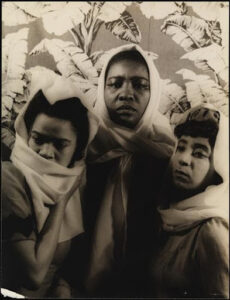American Ballet Theatre and Negro Unit


American Ballet Theatre, called the Ballet Theatre until 1957, was expansive from the outset, consisting of 20 principal dancers; 15 soloists; a company of 56; 11 composers; 11 designers; 11 choreographers; 18 composers; a Spanish unit of 19 dancers; and, finally, an all-Black unit of 16 dancers. This final unit, known as the Negro Unit of Ballet Theatre, emerged as a result of the Works Progress Administration Federal Theatre Project, which employed a large number of Black dancers and choreographers.
Amidst the Great Depression, in 1935, the Works Progress Administration Federal Theatre Project was established by President Franklin Delano Roosevelt’s administration. As part of the effort to revive the economy, the New Deal created Negro units, also known as The Negro Theatre Project (NTP), which were set up in 23 cities throughout the United States. This program, although short-lived (1935-1939), employed hundreds of Black Americans involved in theater and dance. It sponsored both cultural and economic development, celebrating diversity of the arts and underrepresented artists. Directors, dancers, actors, playwrights, and theater technicians benefitted from the program. Additionally, millions of Americans were able to see live theater for the first time. The program is especially notable for its focus on racial justice. As a result, African American theater experienced a much-needed boost during the Depression.
The Negro Unit of Ballet Theatre was made up of 16 Black dancers, including Lawaune Kennard, Lavinia Williams, Anne Jones, Dorothy Williams, Elizabeth Thompson, Evelyn Pilcher, Edith Ross, Valerie Black, Leonore “Azelean” Cox, Edith Hurd, Mabel Hart, Maudelle Bass, Clementine Collinwood, Carole Ash, Bernice Willis, and Muriel Cook.
The Negro Unit only performed one ballet during its existence, entitled Black Ritual or Obeah, which was choreographed by Agnes de Mille and set to a score by Darius Milhaud. Black Ritual was performed only three times over the course of the Ballet Theatre’s inaugural season in 1940, and upon the conclusion of the company’s three-week run at Radio City Music Hall, the Negro Unit was disbanded.
According to the American Ballet Theatre website, some claim the unit disbanded in order to save money, while others say it lacked a singular artistic vision that would carry it forward. The former explanation seems unlikely as the dancers in the Negro Unit were paid only a fraction of what their white corps de ballet counterparts were paid—a mere $10 versus $40 over an unspecified pay period. The Negro Unit’s end can presumably be attributed, at least in part, to Congress’s nationwide elimination of the Federal Theatre Project in June of 1939. The Negro units contributed to the Project’s downfall, as they had drawn a great deal of Congressional fire. As historian Rena Fraden explains, “The idea of autonomous Negro units, leading to a national Negro theatre or a fully integrated American theatre, including whites and blacks equally, threatened the status quo” (Fraden, 199).
Sources:
Rena Fraden, Blueprints for a Black Federal Theatre 1935-1939, Cambridge University Press, 1994
Paula Becker, Negro Repertory Company, History Link
Bethany Beacham, The Beginning: The Negro Unit of Ballet Theatre and Agnes de Mille’s Black Ritual, American Ballet Theatre

McClain Groff

